Click on thumbnail
for full size image |
Size |
Image Description |
Source |
|---|
 |
77k |
"The Japanese Sneak Attack on Pearl Harbor."
Charcoal and chalk by Commander Griffith Bailey Coale, USNR, Official U.S. Navy Combat Artist, 1944.
Courtesy U.S. Navy Art Center, Washington, DC
U.S. Navy photo KN-32031 |
Naval Historical Center |
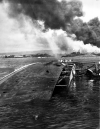 |
111k |
Original photo: c. December 1941
Capsized at 1010 pier, Pearl Harbor, HI
Replacement photo: Lying on her side following the Japanese attack at Pearl Harbor, T.H., on 7 December 1941
National Archives photo 80-G-32537
| Original photo: Hyperwar U.S. Navy in World War II
Replacement photo: Mike Green |
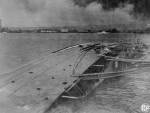 |
100k |
c. December 1941
Capsized at 1010 pier, Pearl Harbor, HI
National Archives photo, San Francisco Regional
Branch, Pearl Harbor Navy Yard General Correspondence 1941-45 |
Tracy White |
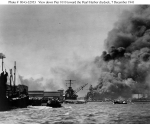 |
83k |
View looking down Pier 1010 toward the Pearl Harbor Navy Yard's Drydock Number One, in center, which holds the battleship Pennsylvania (BB-38) and the burning destroyers Cassin (DD-372) and Downes (DD-375). Alongside Pier 1010, in the center middle distance, are the light cruiser Helena (CL-50), listing slightly from a torpedo hit, and the capsized minelayer Oglala
National Archives photo 80-G-32953 |
Naval Historical Center |
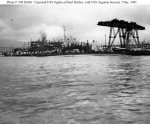 |
111k |
View looking toward 1010 Dock, with Oglala capsized in the foreground. To the left is Argonne (AG-31), with Sacramento (PG-19) barely visible
beyond her
From the collection of Vice Admiral Homer N. Wallin
U.S. Navy photo NH 83066 |
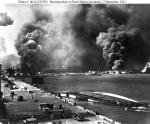 |
124k |
View from Pier 1010, looking toward the Pearl Harbor Navy Yard's drydocks, with Shaw (DD-373), in floating drydock YFD-2, and Nevada (BB-36) burning at right. In the foreground is the capsized Oglala, with Helena (CL-50) further down the pier, at left. Beyond Helena is Drydock Number One, with Pennsylvania (BB-38) and the burning destroyers Cassin (DD-372) and Downes (DD-375).
National Archives photo 80-G-47489 |
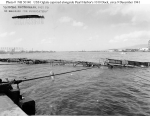 |
82k |
View taken from 1010 Dock, showing the capsized ship's starboard deck edge and embarkation ladder, 9 December 1941, two days after she was sunk in the Japanese attack on Pearl Harbor. In the center distance is the beached and sunken battleship Nevada (BB-36) and destroyer Shaw (DD-373) wrecked in the floating drydock YFD-2, in the left center distance. Ford Island Naval Air Station is at right
Photograph taken by Pearl Harbor Navy Yard
U.S. Navy photo NH 50140 |
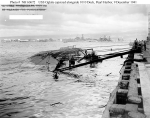 |
113k |
Capsized alongside 1010 dock at Pearl Harbor, 9 December 1941. Preliminary salvage work on her is already underway. "Battleship Row", by Ford Island is in the distance, with Maryland (BB-46) in center, alongside the capsized Oklahoma (BB-37). Astern are West Virginia (BB-48), sunk alongside Tennessee (BB-44). Farthest to the right are the sunken and burned-out remains of
Arizona (BB-39).
U.S. Navy photo NH 60672 |
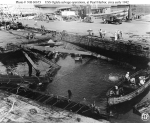 |
143k |
Under salvage alongside 1010 dock at Pearl Harbor in early 1942
U.S. Navy photo NH 60673 |
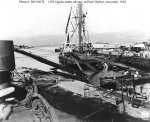 |
119k |
Under salvage alongside 1010 dock at Pearl Harbor in early 1942. The wreck of Arizona (BB-39 is in the left distance
U.S. Navy photo NH 60674 |
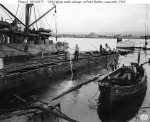 |
125k |
Salvage work underway at Pearl Harbor, circa early 1942. One of Oglala's motor launches is in the right foreground, with a diver embarked. Salvage pontoons (including YSP-17) are in the background, and an oiler is by the Ford Island gasoline wharf in the distance
U.S. Navy photo NH 60675 |
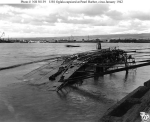 |
91k |
c. January 1942. An oiler is at the Ford Island gasoline wharf in the center distance. In the extreme right distance is the capsized hull of Oklahoma (BB-37)
U.S. Navy photo NH 50139 |
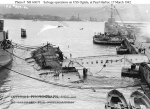 |
120k |
Capsized alongside 1010 dock at Pearl Harbor, with salvage work underway, 17 March 1942. Chains encircling her hull are part of the righting tackle. West Virginia (BB-48) and Arizona (BB-39) are sunk in the middle distance
U.S. Navy photo NH 60671 |
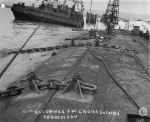 |
161k |
5 April 1942
Chains attached to hull with YSP-17 astern
National Archives photo, San Francisco Regional Branch, Pearl Harbor Navy Yard General Correspondence 1941-45 |
Tracy White |
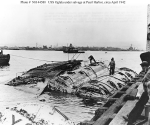 |
120k |
Under salvage alongside 1010 Dock, Pearl Harbor, Hawaii, circa 11 April 1942. YSP-13 and YSP-15 are among the salvage pontoons being used to try to raise Oglala's capsized hull. An oiler and the sunken West Virginia (BB-48) are in the background
U.S. Navy photo NH 44580 |
Naval Historical Center |
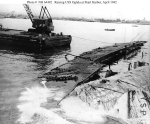 |
114k |
Salvage pontoons (with YSP-13 among them) surfacing during the initial attempt to right the ship, 11 April 1942. This effort failed when some of the pontoons broke loose from their righting bridles. The barge Guam 3201 is at left, with a mobile crane on board
U.S. Navy photo NH 64492 |
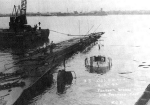 |
166k |
The first attempt to refloat the Oglala fails on April 11, 1942, as the pontoons break free of their chains.
National Archives photo |
Mike Green |
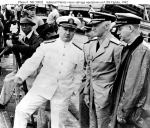 |
136k |
Admiral Chester W. Nimitz, USN, (center), Commander in Chief, Pacific Fleet, observes efforts to right the capsized Oglala (CM-4) at Pearl Harbor. With him are Rear Admiral William R. Furlong (left), Commandant, Pearl Harbor Navy Yard, and Captain Homer N. Wallin (right), who was in charge of the salvage operations. The photograph was taken in April - May 1942, possibly during the initial righting attempt on 11 April
U.S. Navy photo NH 50002 |
Naval Historical Center |
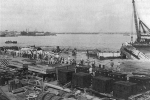 |
166k |
The Oglala is righted alongside the 1010 dock on 23 April 1942. Some of the pontoons are visible, having already come to the
harbor surface.
National Archives photo |
Mike Green |
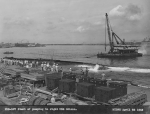 |
117k |
23 April 1942
National Archives photo, San Francisco Regional Branch, Pearl Harbor Navy Yard General Correspondence 1941-45 |
Tracy White |
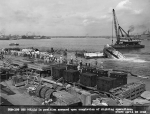 |
161k |
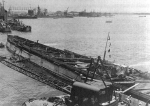 |
264 |
Pacific Bridge employees check the Oglala's cofferdam sections for leaks, as pumps dewater the ship.
National Archives photo |
Mike Green |
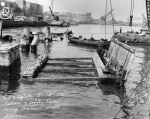 |
182k |
12 May 1942
National Archives photo, San Francisco Regional Branch, Pearl Harbor Navy Yard General Correspondence 1941-45 |
Tracy White |
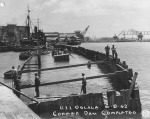 |
142k |
8 June 1942
National Archives photo, San Francisco Regional Branch, Pearl Harbor Navy Yard General Correspondence 1941-45 |
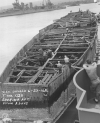 |
144k |
23 June 1942
National Archives photo, San Francisco Regional Branch, Pearl Harbor Navy Yard General Correspondence 1941-45 |
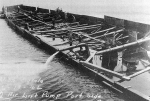 |
173k |
The Oglala is seen being pumped out for the second time. Several pumps failed on June 25, 1942, causing the ship to sink again. The battleship West Virginia and cruiser Northampton are seen in the upper part of the photo, occupying Dry-docks No. 1 and No. 2
National Archives photo |
Mike Green |
 |
145k |
26 June 1942
National Archives photo, San Francisco Regional Branch, Pearl Harbor Navy Yard General Correspondence 1941-45 |
Tracy White |
 |
96k |
3 July 1942
National Archives photo, San Francisco Regional Branch, Pearl Harbor Navy Yard General Correspondence 1941-45 |
 |
138k |
The Oglala is seen on 3 July 1942 being eased into Dry-dock No. 2. The cofferdam assembly, weighing 600 tons, can be easily seen here. The pumps are working to keep ahead of the flooding still occurring. The aircraft carrier Saratoga is moored at Ford Island in the background
National Archives photo |
Mike Green |
 |
114k |
3 July 1942
National Archives photo, San Francisco Regional Branch, Pearl Harbor Navy Yard General Correspondence 1941-45 |
Tracy White |
 |
150k |
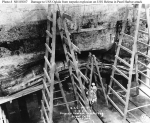 |
158k |
Closeup view of torpedo damage to the ship's port side midships hull, taken 4 July 1942 in drydock at the Pearl Harbor Navy Yard. Oglala was not herself directly hit. The heavy damage to her hull seen here was caused by the explosion of an aerial torpedo on Helena (CL-50), which was alongside some eight feet distant from Oglala.
Courtesy of the Naval Historical Foundation
Collection of The Honorable James V. Forrestal
U.S. Navy photo NH 85007 |
Naval Historical Center |
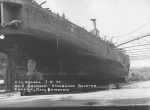 |
83k |
6 July 1942
National Archives photo, San Francisco Regional Branch, Pearl Harbor Navy Yard General Correspondence 1941-45 |
Tracy White |
 |
114k |
 |
118k |
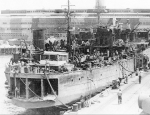 |
134k |
At the Pearl Harbor Navy Yard in mid-1942, after she was salvaged
U.S. Navy photo NH 64236 |
Naval Historical Center |